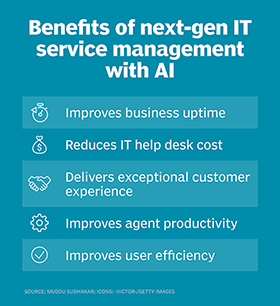
Fotolia
It's time to automate the help desk ticketing system
The help desk is no admin's favorite job -- and no user's favorite place. But with a little automation and AI, the help desk can become a more palatable experience for both parties.
Can the help desk get out ahead of the problems it is there to resolve?
The IT service management (ITSM) industry revolves around an IT help desk that works on issues for internal employees and is underpinned by a ticketing system that tracks the submission and resolution of problems. Ticketing systems have been around for years, and the biggest technology evolution they have undergone of late is to go from being hosted in-house to being offered as a cloud service.
Legacy help desk ticketing systems are reactive, in the sense that someone or perhaps some machine has to open the ticket to report a problem before the IT team can resolve it. Multiple people are involved throughout the whole process. Without a self-service objective, information is not available for self-consumption by users.
ITSM systems are ripe for automation. It's time they get a real makeover, replete with AI, analytics, automation and service agent intelligence.
The drivers for change
CIOs would prefer the process be proactive and even predictive, based on a user's technical issues and history within the system. There are several converging factors that drive the need for proactive, automated help desk ticketing systems.
For one thing, help desk tickets don't just come from humans anymore, but also as machine-generated alerts. When an application starts to have performance issues, the monitoring system that watches for performance anomalies generates a ticket covering that incident directly to the help desk ticketing system. Once you start with machine-generated tickets, the volume of open incidents skyrockets -- humans on the help desk just can't keep up. IT service agents begin to think of these tickets as noise, and might ignore them.
A second factor is that cloud has increased the complexity of computing architectures, from a traditional two-tier client-server relationship to an n-tier architecture driven by APIs. Many applications are tied together through APIs, and those APIs can come from all different vendors. In this complex kind of architecture, it's a challenge for humans to determine the root cause of problems and resolve them.
Around 87% of help desk costs are associated with personnel, according to "How to Determine Your IT Service Desk Staffing Ratio" by Gartner analysts Siddharth Shetty and Chris Matchett. And here we are, adding to service agents' workload by giving them more tickets to respond to and more complex issues to solve, at a time when turnover in these positions is relatively high. Could it be that people don't enjoy being overloaded with work as they tackle mundane problems all day long?
AI and automation for help desk ticketing systems

AI and automation can lift the burden on the help desk team. Information such as historical incidents from the help desk ticketing system, and alerts from various monitoring systems, create excellent input for AI and machine learning systems to form a good parallel to what a human does in terms of root cause analysis. Endpoint and network monitoring systems should be able to provide sufficient historical and ongoing information about a user's issues to proactively resolve them. Instead of a help desk agent chasing down a needle in a haystack, the system can sift through the clues and suggest what the problem might be and how to approach it.
CIOs often list three things that their team doesn't do today that would make their lives much better: resolve tickets, communicate with users and predict issues.
Whether it's a call center, an IT help desk, or a customer service desk, teams resolve tickets manually. The closest they come to automation is run books, written instructions on how to attempt to resolve a problem. Who among us hasn't received absurd instructions -- "Your internet connection will work better if you just turn off your firewall." -- from a help desk agent reading from a script?
This conundrum illustrates the second CIO complaint -- that users are frustrated because they don't get the right information. To resolve an issue, the user has to talk to too many agents, and they get inconsistent information from one to the next. Many users would prefer to get accurate information in a self-service format.
Thirdly, if help desk teams can predict outages, they can address an issue before there is serious downtime.
In essence, CIOs want IT help desk ticketing systems that enable operations to be proactive, predictive, prescriptive and personalized. Those four P's can be addressed with four A's: AI, analytics, automation and agent intelligence.
AI comes into play to correlate historical and diverse information. Analytics complements AI when there is a lot of information in different repositories. AI can help identify the best piece of information to solve an issue, and analytics can say this was the best performing outcome for customers this month. Automation is where the help desk actually performs the actions to solve a problem. Agent intelligence, which is the last piece, says that the service agents get empowered to reduce their time to resolution for complex incidents.








